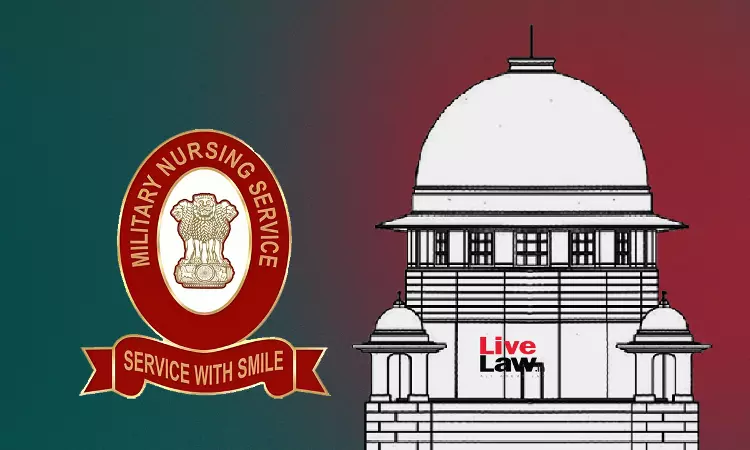Disservice To The Military Florence Nightingale Undone By The Supreme Court
Ananya Sharma & Roopan Atwal
8 May 2025 12:31 PM IST

A SNAPSHOT
A Division Bench of the Supreme Court comprising Justice PS Narsimha and Justice Manoj Misra recently paved the way for the first ex-Military Nursing Service (MNS) Short Service Commissioned Officer (SSCO) to be inducted into the Punjab Civil Services under the Ex-Servicemen (ESM) category (Civil Appeal 5235/2025 Irwan Kour Vs Punjab Public Service Commission & Ors decided on 16-04-2025). Captain Gurpreet Kaur, a retired MNS officer took the Punjab Civil Services (PCS) Examination – 2020 under the ESM category, sans the apprehension that an uphill and long legal battle awaited her. It is yet another story that despite women now being an integral part of the mainstream Defence Services, the terminology “Ex-ServiceMAN” has still not been changed into a gender-neutral term, such as “Ex-Servicemember” or “Ex-Service Personnel”, but we will leave that for another day.
Capt Kaur's candidature for the PCS was rejected by the Punjab Public Service Commission on the ground that being an officer of the MNS, she could not be considered an ESM in terms of some correspondence received from the Kendriya Sainik Board. On the last working day of the then Acting Chief Justice, Justice Ritu Bahri (before she joined as the Chief Justice of the Uttarakhand High Court), a Division Bench of the Punjab and Haryana High Court comprising her and Justice Aman Chaudhary had ruled Capt Kaur to be fully falling within the definition of ESM as per the Punjab Recruitment of Ex-servicemen Rules, 1982 (“State Rules, 1982”). The Bench directed the State of Punjab to appoint her as a PCS officer with notional benefits of service (LPA 636/2022 Gurpreet Kaur Vs Punjab Public Service Commission decided on 03-02-2024).
A private Respondent before the High Court, namely, Ms Irwan Kour, (a retired officer from the Army Medical Corps who had also applied under the ESM category and was appointed as a PCS officer), had impleaded herself as a party before the High Court and challenged the decision through a Special Leave Petition before the Supreme Court on various grounds, including that it had been clarified by the Central Government that the Central Ex-Servicemen Amendment Rules, 2012 (“Central Amended Rules, 2012”) would not cover MNS officers in the definition of ESM, and further, that the directions of the High Court in appointing Capt Kaur would endanger the Appellant's position as an already serving PCS officer.
THE HISTORY OF MILITARY NURSING SERVICE AND THE UNNECESSARY ARTIFICALLY CREATED CONTROVERSY
The MNS has its origins in 1888. The MNS in the current form was raised as an “Armed Force” of the Union of India as part of the Indian Army vide an Ordinance in the year 1943 and is duly recognized as an integral part of the Armed Forces of India. The members of MNS are appointed by the Central Government with a commissioned rank of the Indian Army. The MNS is the only all-woman branch of the Defence Services in India.
Historically, retired MNS officers were provided ESM benefits under the Central Ex-Servicemen Rules, 1979 which defined “Ex-Servicemen” as those who retired or were released on competition of terms from the “Armed Forces” of the Union of India. The pensioners from the MNS from the Permanent Commission Cadre were treated as ESM and so were the SSCOs of the MNS who were compulsorily released after a minimum 5 years of service. However, over the years, the Central Rules were amended and the term “Armed Forces” was replaced with “Regular Army” (See the Central Ex-Servicemen Amendment Rules, 2012/”Central Amended Rules, 2012”) with the purpose of distinguishing Defence Services (Army, Navy and the Air Force) from other Armed Forces, such as the Central Armed Police Forces (CAPFs), such as the BSF, CRPF etc., which are also officially categorized as “Armed Forces” of the Union of India.
Hyper-technically picking on this change in terminology, the Kendriya Sainik Board, which functions under the Ministry of Defence (MoD) issued letters in 2019 and 2021 stating that the MNS officers are not ESM since the MNS did not fall within the “Regular Army”. This despite the fact that in 2014, the same Kendriya Sainik Board had clarified that MNS would, in fact, fall under the definition of ESM. It was only from 2019 onwards that their stance seemed to switch from the logical to the absurd, just because apparently some MNS officers had applied to be appointed for posts under various Sainik Boards. What was interesting to note in this was that the Kendriya Sainik Board has no standing to comment on statutory rules under the Constitutional Rules of Business and is merely a board looking after various welfare activities under the MoD.
Interestingly, as far as the Central Amended Rules, 2012 were concerned, the matter was thereafter taken up by the Chiefs of Staff Committee which is the apex body of the Defence Services, which agreed with an earlier High-Level Committee on the subject under the MoD, on its findings that the ESM status of MNS officers was “well-established”. The observation of the committee was ultimately approved by the Defence Minister. Despite the approval, the Kendriya Saink Board continued to refuse issuance of ESM cards to MNS Officers.
The worst effect of this was on SSCOs of the MNS who now, after their release from MNS in five or more years without pension, became unemployable for civil government jobs since they were now being released on completion of their contractual service in middle age without any reservations or benefits of their military service and without any age relaxation as is applicable to ESM, thus leading to an uncertain future at a time when familial responsibilities are at peak. Military service, hence, became a disqualification rather than a qualification as compared to their peers who joined other services and organizations, and also male and female officers joining branches of the Army other than the MNS who faced no such disqualification. Not only was this discriminatory and illogical, but also highly exploitative of young women who served in the MNS during the times of their lives only to be discarded and left unemployable, having crossed the prime of their lives and rendered ineligible due to age and other criteria due to time spent in the military.
THE CASE AND THE JUDGMENTS OF THE HIGH COURT AND THE SUPREME COURT
The argument of Capt Kaur before the Courts was that Central Amended Rules, 2012 would not apply to recruitments made under the State of Punjab, as the State Rules of 1982 were enacted by the State in exercise of powers under Article 309 of the Constitution, and the State Rules, 1982 which were substantially different than the Central Amended Rules, 2012, provided for the requirement of a person to have served in the “Military” and the “Armed Forces” to be eligible for ESM status, and not the “Regular Army” which was a term used in the Central Amended Rules, 2012. Capt Kaur had also argued, that in any case, the MNS would also very much fall within the definition of “Regular Army” since the branch was recognized by the Army Act as a part of the Regular Army and also by the Defence Services Regulations.
The High Court and the Supreme Court agreed with such contention and rejected the ground urged by the State of Punjab that the clarifications issued by the Kendriya Sainik Board, an advisory body for re-settlement and welfare of retired personnel, would have any bearing over the Punjab State Rules, 1982.
The Supreme Court finally found Capt Kaur eligible to be appointed in the PCS and also clarified that the Appellant's (Ms Irwan Kour's) appointment already effectuated would not be affected by the appointment of Capt Gurpreet Kaur, protecting the interests of both the parties.
More importantly, the Court noted that the restrictive interpretation of rules and insistence on denial of ESM status to retired personnel of the Military Nursing Service (MNS) would demoralize the youth from joining the Defence Forces, knowing that their future would be bleak after their eventual release from military service. Such a practice, especially in Punjab, which contributes 7% to the military despite making up only 2% of the population of the country, would, no doubt, be a discouraging exercise.
THE IRONY
Though the MNS is celebrated as a form of “nari shakti” in ceremonies and parades, the irony in the entire episode is the uncalled-for roadblocks created for MNS officers through the years- not because of systemic discrimination by the government, but due to wanton prejudice based on hyper-technical interpretation of rules and contradictory letters issued by various authorities, which the senior hierarchy, despite its good intentions, has not been able to control or curtail, at times even after assurances and orders issued by the highest political executive. Even in the past, pin-pricks have been initiated which resulted in litigation, which seemed more of personality-oriented ego battles. One such issue was denial of salutations, precedence, star-plates corresponding to their military rank, and ancillary respect to the military rank held by MNS officers by other members of defence services. Despite Regulation 733(b) specifically laying down the inter se precedence, policy letters were issued to deny precedence and status to such officers. The regulation runs as under:
“Women officers serving in the Army Medical Corps and officers in the Military Nursing Service will rank equally with male officers of the same titular rank, e.g., a captain (woman officer) in the Army Medical Corps, will rank equally with a captain in the Artillery or Engineers.”
At one time, the rules provided for compulsory retirement of MNS officers if they got married. Examining this issue, the Supreme Court in Union of India Vs Ex-Lt Selina John (Civil Appeal 1990/2019) decided on 14-02-2024, had observed the following:
“This rule, it is accepted, was applicable to only women nursing officers. Such rule was ex-facie manifestly arbitrary, as terminating employment because the woman has got married is a coarse case of gender discrimination and inequality. Acceptance of such patriarchal rule undermines human dignity, right to non-discrimination and fair treatment. Laws and regulations based on gender-based bias are constitutionally impermissible. Rules making marriage of women employees and their domestic involvement a ground for disentitlement would be unconstitutional.”
Despite the many hurdles in their long path to justice, MNS officers have performed their duty with utmost dedication. In an ideal situation, it was not the MNS officers who should have been fighting for their rights, and a serious thought should have been rendered to resolving their genuine grievances in-house without resort to litigation or adversarial stands in courts. Egotistical stands should have yielded to real camaraderie.
In the crusade against prejudice and gender discrimination, the Constitutional Courts have repeatedly come to the rescue of women and ensured substantive equality in the forces, but more than that, it is the duty of the defence services themselves, and the society at large, to effectively ensure the adherence to the avowed principles our nation stands for.
Ananya Sharma, a law graduate, is currently working with an American company as an in-house counsel.
Roopan Atwal is a practising advocate at the Punjab and Haryana High Court.
Views Are Personal.


